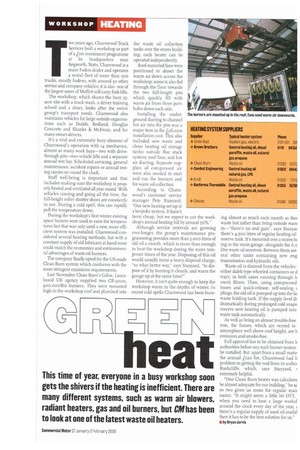T wo years ago, Charnwood Truck Services built a workshop as
Page 43

If you've noticed an error in this article please click here to report it so we can fix it.
part of afrm investment programme at its headquarters near Kegworth, Notts. Charnwood is a main Foden dealer and operates a rental fleet of more than coo trucks, mostly Foclens, with around 30 other service and company vehicles; it is also one of the largest users of Moffett self-carry fork-lifts.
The workshop, which shares the busy 35acre site with a truck wash, a driver training school and a diner, looks after the entire group's transport needs. Charnwood also maintains vehicles for large outside organisations such as Dodds, Redland, Douglas Concrete and Shanks & McEwan, and for many owner-drivers.
It's a vital and extremely busy element of Charnwood's operation with 14 mechanics, almost as many work bays—two with drivethrough pits—two vehide lifts and a separate annual test bay. Scheduled servicing, general maintenance, accident repairs or annual testing carries on round the dock.
Staff well-being is important and that includes making sure the workshop is properly heated and ventilated all year round. With vehicles corning and going all the time, the full-height roller shutter doors are constantly in use. During a cold spell, this can rapidly pull the temperature down, During the workshop's first winter existing space heaters were used to raise the temperatures but that was only until a new, more efficient system was installed. Chamwood considered several heating methods, but with a constant supply of old lubricant at hand none could match the economics and environmental advantages of waste-oil burners.
The company finally opted for the US-made Clean Burn system which conforms with the most stringent emissions requirements.
Last November Clean Burn's Colne, Lanesbased UK agency supplied two CB-500o, 400,00oBtu burners. They were mounted high in the workshop roof and plumbed into the waste oil collection tanks over the stores building; each heater can be operated independently.
Roof-mounted fans were positioned to direct the warm air down across the workshop; some is also fed through the floor towards the two full-length pits which quickly fill with warm air from three portholes down each side.
Installing the underground ducting to channel hot air into the pits was a major item in the126,000 installation cost. This also included new waste and clean heating oil storage tanks; outside flue stack system; roof fans; and hot air ducting. Separate supplies of compressed air were also needed to start and run the burners and for waste oil collection.
According to Charnwood' s customer service manager Pete Stanyard: "Our new heating set-up is a bespoke system. It hasn't been cheap, but we expect to cut the workshop's annual heating bill by around 50%."
Although service intervals are growing ever-longer, the group's maintenance programming provides more than 3,000 litres of old oil a month, which is more than enough to heat the workshop during the more temperate times of the year. Disposing of this oil would usually incur a heavy disposal charge, "so what better way," says Stanyard. "to dispose of it by burning it cleanly, and warm the garage up at the same time?"
However, it isn't quite enough to keep the workshop warm in the depths of winter. In recent cold spells Charnwood has been burn
ing almost as much each month as thei waste but rather than bring outside wasti in—"there's no real gain", says Stanyar there's 4,500 litres of regular heating oil reserve tank. It's mounted over a stores be ing in the main garage, alongside the 6,c litre waste oil reservoir. Between them are eral other tanks containing new eng transmission and hydraulic oils.
Waste oil is drained from the vehicles either dalek-type wheeled containers or d trays; in both cases running through k mesh filters. Then, using compressed hoses and quick-release. self-sealing c plings, the old oil is pumped up into the la] waste holding tank. If the supply level dr dramatically during prolonged cold snaps reserve new heating oil is pumped into waste tank automatically.
As well as being an almost trouble-free tern, the fumes, which are vented to atmosphere well above roof height, are b emission and smoke-free.
Full approval has to be obtained from h authorities before any such burner system be installed. But apart from a small matte the annual LI20 fee, Charnwood had Ii problem in getting the nod from its autho, Rushcliffe, which, says Stanyard, extremely helpful.
"One Clean Burn heater was calculate( be almost adequate for our building," he ac so two gives us room for regular main nance. "It might seem a little bit OTT, when you need to heat a large works' around the clock every day of the year, there's a regular supply of used oil availal then it has to be the best solution for us."
• by Bryan Jarvis












































































































